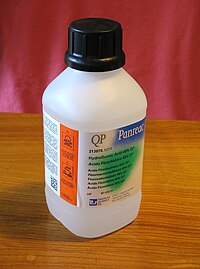
Photo from wikipedia
Abstract Two sets of activating solutions with increasing sodium hydroxide contents were prepared either with or without silicates. Their buffer capacities, i.e. their ability to resist changes in pH, were… Click to show full abstract
Abstract Two sets of activating solutions with increasing sodium hydroxide contents were prepared either with or without silicates. Their buffer capacities, i.e. their ability to resist changes in pH, were determined and compared using the Hammett acidity function, a measure of acidity appropriate for concentrated solutions. This is the first time the Hammett acidity function of sodium silicate solutions has been measured. The effects of the buffer capacity and of the initial Hammett acidity function on the reactivity of metakaolin-based pastes were assessed using isothermal conduction micro-calorimetry. The reactivity of metakaolin in sodium hydroxide solutions is shown to be directly related to the initial Hammett acidity function, whereas for sodium silicate mixtures, the buffer capacity is a more pertinent parameter. The mechanism deduced for the role of hydroxide ions during geopolymerization also highlights the role of silicate species as a hydroxide reservoir that nurtures the dissolution process.
Journal Title: Cement and Concrete Research
Year Published: 2019
Link to full text (if available)
Share on Social Media: Sign Up to like & get
recommendations!